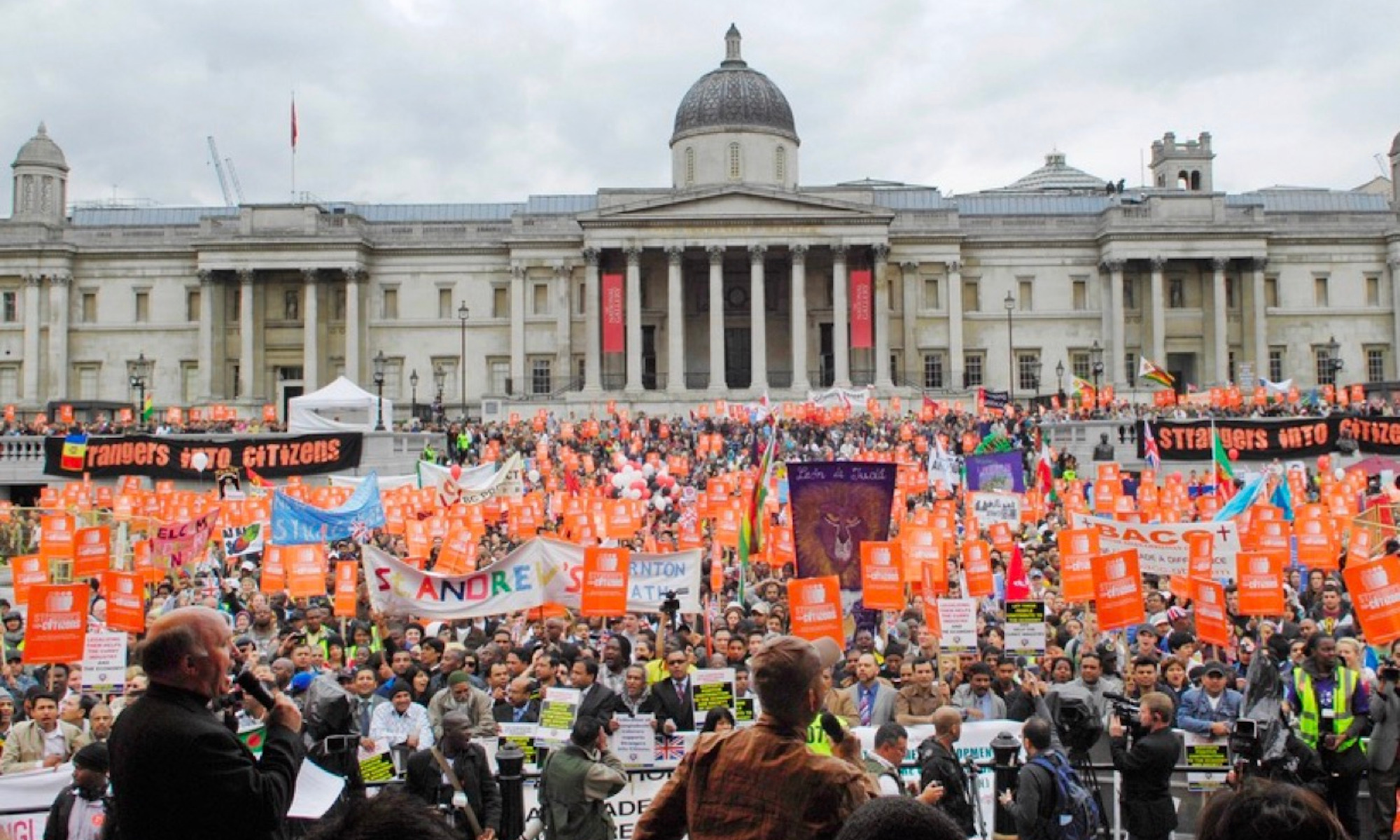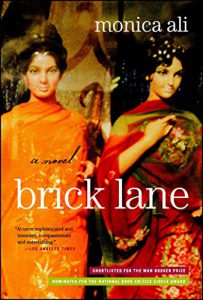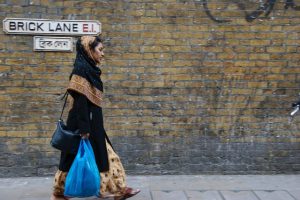

 A map showing Tower Hamlets and Brick Lane/Google Maps
A map showing Tower Hamlets and Brick Lane/Google Maps






Multicultural London:
The Literature of Migrants and Immigrants
ENG 399, Spring 2021


 A map showing Tower Hamlets and Brick Lane/Google Maps
A map showing Tower Hamlets and Brick Lane/Google Maps





Monica Ali’s portrayal of London and Nazneen’s experience as an immigrant is, to a great degree, inflected by a comparison to which Ali repeatedly returns – Hasina’s experience in her homeland of Bangladesh. The epistolary form of Hasina’s narrative – and its role in Nazneen’s life – is an issue that often perplexes readers and critics alike, especially given the seemed stereotypes that litter Hasina’s narrative. What critics tend to overlook, however, are the subtle ways in which Ali subverts or complicates both Nazneen and Hasina’s characterisations. In this paper, I will argue how it is fruitless to interpret the inclusion of Hasina’s life in Dhaka as a foil intended to project certain messages about the ability of London to enrich an immigrant’s life through providing them with the tools to emancipate themselves. Rather, Ali seeks to create a more nuanced portrayal of how London uniquely shapes the life of a few immigrants and how in doing so, she evades totalisations of the immigrant experience in London. I argue that the lengths Ali goes to in order to establish the distinctness and individualisation of Nazneen’s experience, combined her depiction of fringe characters, such as Chanu and Razia, as they interact with London and British culture absolves Ali from the “burden of representation”.
Nazneen’s experience of London as an immigrant is explicitly and implicitly represented in a comparative manner, with Hasina’s experiences in Bangladesh acting as a sort of proxy for what Nazneen’s life could have been like. Many critics have identified the portrayal of Hasina as a stereotype, with her continual suffering and misadventures cementing her status as a symbol of subjugation. Pankaj Mishra of the New York Review of Books even likens Hasina’s letters to that of a tourist, stating ‘at times, Hasina sounds more like a travel writer from England than an oppressed woman from Bangladesh, especially when she reports on the rickshaws in Dhaka painted with the face of Britney Spears’. Attempts to reconcile such depictions have led to a variety of different inferences as to Ali’s attempted meaning behind Hasina’s letters. Jane Hiddleston in her essay “Shapes and Shadows: (Un)veiling the Immigrant in Monica Ali’s Brick Lane” explores how the stereotypical representation of Hasina draws attention to the way in which myths circulate around both the culture of London and that of Dhaka. For Hiddleston, Hasina’s letters are ‘testimony to the pervasiveness of such stereotypes in Bangladesh as well as in Britain, and their inclusion in a novel…forces us to consider the difficulty of attempting to free any representation of cultural identity from their influence’ (63). Hiddleston’s analysis of the purpose served by Hasina’s epistolary presence within the novel illustrates the tendency to view Hasina’s experience relatively to Nazneen’s London life. For Hiddleston, it is the inclusion of Hasina that allows Ali to shed light on the mythic immigrant narrative that revolves around London.
Michael Perfect in his essay “The Multicultural Bildungsroman: Stereotypes in Monica Ali’s Brick Lane” further scrutinizes the dialogue of controversy surrounding Hasina’s portrayal and how it inflects Ali’s portrayal of London and the immigrant experience. He expresses how many critics have sought to ‘emphasise [the use of stereotype’s] sense of knowing irony in doing so’ (110). Perfect rejects this interpretation of stereotypes within the novel, arguing instead that the presentation of Hasina’s life in Bangladesh as a contrapositive to Nazneen’s experience as an immigrant in London serves to celebrate integration. He argues that stereotypes are employed as ‘aesthetic counterpoints in order to further emphasise the protagonist’s final integration into contemporary British society’ (110). Perfect works to undermine the assumption that Ali ironically utilises stereotypes in the text. He identifies Naila Kabeer’s book The Power to Choose as a source of inspiration for Ali. In fact, many of Hasina’s anecdotes and experiences seem to have been directly pulled from testimonies of female Bangladeshi garment workers expressed in Kabeer’s book. Perfect notes that Ali appropriates these testimonies, picking ‘the most despairing ones that Kabeer’s study has to offer’ and that she ‘occasionally modifies them to make them even bleaker’ (118). In this way, Perfect argues that Ali alters the fundamental message of Kabeer’s book, which is to demonstrate that ‘it is the women in Dhaka rather than London who are experiencing an increase in personal agency; indeed, in their “power to choose”’ (118). Perfect concludes that Ali’s use of stereotypes in her representation of Hasina is integral to Ali’s message – that ‘Nazneen does not lose her identity in multicultural London but rather discovers it’ (119).
Both critical responses to the use of stereotypes in Ali’s novel seem to depend on a certain critical gaze whereby life as an immigrant in London is necessarily inflected by a contrapositive of life in Dhaka. In this interpretation, Hasina’s life as a Bangladeshi native in her hometown of Dhaka is used relatively as a foil to portray the effect of London in providing Nazneen the tools and opportunity for self-empowerment. The concern surrounding the use of stereotypes reveals a somewhat fundamental assumption about the function and purpose of the immigrant novel – to authentically represent an underrepresented group of people. In this way, Ali’s novel does indeed suffer the “burden of representation”. I argue, conversely, that Ali complicates a generalised interpretation of the life of a Bangladeshi immigrant in London. She does this through her intricate, distinct and personalised portrayal of Nazneen and her interaction with specific locales in London. Further, she elucidates the perspectives towards and experiences of London through the eyes of other characters, such as Chanu. Finally, she provides key details that push back against the perceived representation of Hasina in Dhaka as the innocent and uneducated contrapositive to what Nazneen would have become had she not been liberated and freed by the city of London.
Ali attempts to avoid the generalisations that often accompany readings of immigration novels by seeking to portray London as distinctly and uniquely experienced under Nazneen’s gaze. Firstly, Ali seeks only to expose a portion of London, with Nazneen confined mostly to her apartment and few other key locations. For the first few chapters, Nazneen’s experience of London is limited to her flat and housing estate. Becoming accustomed to her surroundings, Nazneen notes, ‘She walked slowly along the corridor, looking at the front doors. They were all the same. Peeling red paint showing splinters of pale wood, a rectangular panel of glass with wire mesh suspended inside, gold-rimmed keyholes, stern black knockers.’ (36). Ali’s use of detailing draws attention to the individuality of the way in which Nazneen experiences London. For Nazneen, London has already become uniform, predictable and familiar. Far from the seeming “immigrant trope” of the new land being foreign and alien, Nazneen perceives London in a way that complicates this stereotype. When she does venture into the city and moves beyond Brick Lane for the first time, she notices, ‘Men in dark suits trotted briskly up and down the steps, in pairs or in threes. They barked to each other and nodded sombrely.’ (39). Nazneen analyses the men she passes as one would a flock of animals. They are described in similar terms, no one individual differentiated from another. They come in pairs or threes, and “bark” – a term more frequently applied to dogs than humans. On one hand, Ali may serve to describe these men in a manner that emphasises Nazneen’s dissociation from the cultural landscape she finds herself in. However, at the same time, the seemed homogeneity of these men underlines the monotony and limitation of London life – a far cry from the diversity and variety the foreign land is expected to offer in the typical immigrant narrative.
The idea that immigrant life in London is posed as a favourable alternative to life in Dhaka is also complicated by the characters who operate at the fringes of Nazneen’s narrative. Chanu’s understanding of London culture is complex and paradoxical. Nazneen says of his decision on what his daughters shall wear, ‘If he had a Lion Hearts leaflet in his hand, he wanted his daughters covered. He would not be cowed by these Muslim-hating peasants. If he saw some girls go by in hijab he became agitated at this display of peasant ignorance. Then the girls went out in their skirts.’ (217). Chanu’s seemingly paradoxical behaviour – dressing his daughters traditionally upon feeling threatened by lower-class bigots only to demand that they wear more mainstream clothing when wanting to differentiate himself from other Muslims – serves to dissect and critique the idea that London is converse to Bangladesh. People from both groups are deemed “peasants” in Chanu’s eyes (whether Chanu’s use of the term “peasant” in both cases is justified is another argument), thus diminishing the idea that the process of enlightenment and empowerment is unique to London and alien to a country like Bangladesh.
Razia’s story also offers a unique perspective in order to complicate the idea that London offers a sense of freedom and autonomy unavailable to women in Dhaka. As Nazneen discusses her adultery to Razia, her friend explains that to be “in love” is the “English style” (360). Nazneen reacts, ‘How irritating Razia could be sometimes! Who was it who made herself so English, anyway? With her British passport and tracksuit and Union Jack sweatshirt…She would not ask for Razia’s opinion now. She would do as she pleased.’ (360). The embrace of British culture, seemingly embodied through the character of Razia, is here rejected by Nazneen, who responds with a sentiment bordering on disgust. While Nazneen’s affair suggests a turning away from Bengali tradition and a greater acceptance of a freer and more autonomous “British” culture, Nazneen simultaneously rejects London, deciding rather to “do as she pleases”.
Just as Ali undoes the generalisation of London as a pinnacle of emancipation for immigrants through Nazneen’s perspective, she similarly complicates the interpretation of Hasina as the innocent and helpless Bangladeshi contrapositive. Hasina, unlike Nazneen, is considered to be the one who ‘kicks against her fate’ (10) by marrying for love – a tradition that Razia later ironically labels British. Furthermore, just as Nazneen moves from the village to the city, so does Hasina; ‘In morning soon as husband go out for work I go away to Dhaka.’ (41). The idea that Nazneen’s village innocence informs the empowering effect London has on Nazneen is thus discredited. Both sisters move to the city and as such, this binary of Dhaka and London is not one of village and city, but rather city and city. Furthermore, Hasina’s choice to leave her husband, albeit due to domestic violence, predates Nazneen’s own choice to leave Chanu later in the novel. It is Hasina who is arguably more emancipated and self-autonomous than Nazneen – at least initially. Far from the innocent and naïve Bangladeshi “peasant”, as Chanu would say, Hasina proves to be resourceful, autonomous and ultimately successful in finding a secure position as a maid for a wealthy couple with anglicised names – James and Lovely.
The call for authenticity in representing underprivileged communities in immigrant novels places Monica Ali’s novel Brick Lane under pressure, specifically in regard to the stereotypes she employs. The controversy surrounding Ali’s portrayal of Hasina places focus on how the depiction of London is inflected by a contrapositive experience in Dhaka. However, Ali goes to great lengths to avoid totalising London and the immigrant experience through her unique portrayal of Nazneen’s interaction with London and the spaces she explores, the perspective of Chanu and his paradoxical experience of British society and the complication of Hasina’s characterisation.
Works Cited:
Ali, Monica. Brick Lane: A Novel. First Scribner trade paperback edition.
Hiddleston, Jane. “Shapes and Shadows: (Un)Veiling the Immigrant in Monica Ali’s Brick Lane.” Journal of Commonwealth Literature, vol. 40, no. 1, 2005, pp. 57.
Perfect, Michael. “The Multicultural Bildungsroman: Stereotypes in Monica Ali’s Brick Lane.” Journal of Commonwealth Literature, vol. 43, no. 3, 2008, pp. 109.
This essay represents my own work, in accordance with University regulations.
“It was as if she had woken one day to find that she had become a collector, guardian of a great archive of secrets, without the faintest knowledge of how she had gotten started or how her collection had grown. Perhaps, she considered, they just breed with each other. And then she imagined her secrets like a column of ants, appearing at first like a few negligible specks and turning so quickly into an unstoppable force” (228).
Introduction
Unlike adventurous protagonists in the tradition of the realist novel such as Oliver Twist and Jane Eyre, Nazneen is confined to the domestic arena and draws her power only from within. This is hinted at in the epigraphs announcing fate as the major theme of the novel. Because each of Nazneen’s attempts to forge into the outside world is considered a transgression in her society, she turns into a “guardian of a great archive of secrets”: her first walk in the city; her sister’s despair; her knowledge of Tariq’s descent into drugs, and most significantly the affair with Karim, are all secrets. While her husband, Chanu, conceals to abscond responsibility and soften his wounding humiliations, Nazneen uses secrecy to test the suffocating social boundaries around her before eventually breaking free from them.
As the secrets compound, the gulf between Nazneen and her husband widens, and by the end of the novel, the roles of husband and wife in the family have completely reversed. Secrecy allows Nazneen to ascertain her power and attain selfhood, sharpening her perception and allowing her to establish roots in the city, even as the marriage crumbles.
I: Quiet Rebellion
Mishra (2003) finds Chanu’s depiction is fuller than Nazneen’s. This is indeed a correct first impression. But if one takes Nazneen’s secrecy into account, she acquires a more complex interiority. In the first half of the novel, Nazneen’s secrets afford her a quiet rebellion, a profound rejoinder to Chanu’s hollow tirades.
While Chanu’s past is only one of glory, Nazneen’s is more nuanced. She clings to the legend of her nativity: Nazneen had been taught that she had survived her childhood only because she was surrendered to fate. Her mother, Amma, downplays the role she had played in nursing the daughter and instead attributes it to fate. This grants the child freedom from life’s drudgery and banishes all ambition. For a woman, the desire for self-improvement is itself considered a sin. But Nazneen’s life is nothing but toil: she submits to her father, who marries her off to Chanu. And at her house, she essentially becomes a maid, tending only to Chanu’s needs: she cuts his corns and trims his nails. Because there is no satisfaction in such humiliating work, Nazneen falls back into her mother’s philosophy: she surrenders to fate, which justifies the toil and gives her a different source of purpose, a purpose she may have found in a job of her own. Unrooted and displaced in London, Nazneen grounds herself in tradition. She draws resilience from the conviction that there is nothing she can do about her life. “What could not be changed must be born,” was how Amma had put it (p. 4). But the toil becomes too unbearable for Nazneen and she quietly rebels. These transgressions gather into secrets.
When Jorina, a woman in the neighborhood, commits suicide, Nazneen is concerned. The news is broken by Mrs. Islam, whose authority over the neighborhood rests solely on her archive of secrets. For women, secrecy is a source of power. This is made more explicit when Nazneen inquires about why Jorina had killed herself. “You can hardly keep it a secret when you begin going out to work,” Razia theorizes (p. 13). The woman’s sin, it turns out, was that she had found a job for herself. This piques Nazneen’s curiosity. She formulates a question about Jorina’s death, rephrasing it endlessly, but she never gathers enough courage to pose it to Chanu. This sets the ground for her rebellion.
When Nazneen accompanies Chanu to Dr. Azad’s practice, he introduces her as “shy”, but she locks eyes with the doctor, finding herself “caught in a complicity of looks” (p. 19), which threatens to give off what her husband is not saying. Although she has no role in the conversation, she still manages to tip Chanu off. Nazneen also represses her desire to act, secretly hatching plans in her head, which compensate for her passivity. “She wanted to get up from the table and walk out of the door and never see [Chanu] again” (p. 18). So forceful is her desire for rebellion even when she is completely subdued.
Nazneen’s first true transgression is the walk she makes to the city by herself, unaccompanied by her husband. This journey represents independence. Chanu confines her to the house, locked from the outside world. Embarrassed, he also hides the details of his job from Nazneen. He wants to live with her in the same house but still somehow maintain a distance, keeping the assaults against his manhood only to himself. Even in his ramblings, Chanu manages to remain obscure, rarely briefing Nazneen on the true contents of the books he reads, claiming that they are not easy to translate. This forces Nazneen to forge into the city on her own. And when she takes the walk to the city and makes it back to her house safely, having asked for directions, this cements Nazneen’s power and bolsters her self-confidence. “See what I can do,” she says to herself, addressing Chanu, although she cannot yet summon the courage to tell him about the walk (p. 40). At least she discovers she no longer has to rely on him. And this must be kept a secret: he wields too much power over. If Nazneen confesses her transgression, Chanu may restrain her and this is not a risk she is ready to take.
But Nazneen finds a different outlet for action. Her sister, Hasina, writes to her from home to tell her that she had escaped from her husband to Dhaka. This is Hasina’s secret and no one in the village knows about it. Nazneen is convinced her sister’s action will put her in great peril. “Once you get talked about, then that’s it,” she confirms (p.38). A woman is only safe as long as she remains servile to her husband; if she breaks free, that is the end for her, as has been the case of Jorina. Nazneen is worried such a fate is awaiting her sister and she appeals to Chanu for action. But Chanu downplays the sister’s case and instead sympathizes with the husband, whom Hasina had confessed had brutally beaten her. “What will happen will happen,” Chanu says, echoing Amma’s philosophy of submission to fate. Nazneen feels betrayed and withholds Hasina’s future letters from her husband. This, she believes, is a case she must take up on her own. For the first time, she punishes Chanu for the grievance. She stops praying for his promotion, puts “fiery chilies’ into his sandwich, slips the razor when cutting his corns, and registers her rebellion in all the chores she undertakes (p. 40). But Chanu barely notices Nazneen’s discontent. If anything, he suppresses her even more. For instance, when Nazneen suggests enrolling in Razia’s college, Chanu feigns indifference (p. 51). This confirms to her that she cannot rely on him for anything. Nazneen must rebel more fiercely.
II: The Affair
Walter (2003) finds fault with Hasina’s letters, writing, “I don’t quite understand why Hasina’s letters are written in such broken prose, since presumably she would write in her own language”. This ignores the fact that spelling mistakes can also occur in the Bengali language. But the true distinction between the sisters is one of temperament. Nazneen admires Hasina’s broken spelling and finds her correspondence more lively than her own letters, which are anguished and forever in search of perfection. Gorra (2003) lucidly captures the true intention of Hasina’s letters. “Hasina’s account of her life in a desperately poor city [tells] Nazneen that the “home” she imagines no longer exists,” he writes.
Hasina’s desperation is clearly overstated. Mishra (2003) points out that Hasina “sounds more like a travel writer from England than an oppressed Bangladeshi woman”. However, there is no doubt that Hasina’s grim experience back home alleviates Nazneen’s nostalgia and grounds her in the city. This is a secret she withholds from the tormented Chanu, until later in the novel. But her sister’s correspondence is not enough solace for Nazneen. The “external three-way torture of daughter-father-daughter” becomes too unbearable for her (p. 147).
This slowly leads to Nazneen’s biggest secret. Estranged from her husband, Nazneen begins dreaming of finding a job for herself and sending money to Hasina (p. 133). She swings into action and masters “basting, stitching, hemming, buttonholing and gathering” (p. 139). In this way, she invents a job for herself without leaving the house, as Jorina had been forced to do. At this point, Nazneen also finds out that Chanu had taken a loan from Mrs. Islam and she confronts him about it. As always, he merely ignores her. But when Nazneen starts working at home, Chanu does not ask her to stop; instead, the roles of wife and husband reverse and he begins helping her, “passing scissors, dispensing advice, making tea, folding garments (p. 147.” He desperately wants to be in charge, even calculating the profit margins on her behalf. Chanu is unmotivated and he has given up his big ambitions. He has essentially resigned to fate. “Now, I just take the money, I say thank you. I count it,” he says (p. 154). This sense of despair bothers Nazneem and she desperately wants an escape.
This is when Nazneen falls for Karim, the middleman who brings her the garments. Unlike Chanu, Karim is a man of action; in fact, his favorite catchphrase is “man”. Though he is of the same generation as Tariq, Karim is different. Where Tariq steals from his mother (saying “Ok-Mama” to everything she says) and succumbs to drugs (a secret Nazneen picks on early but never discloses to Razia), Karim rebels from his parents and loathes them intensely. He scolds his father for spending too much money calling back home and faults him for growing passive after decades of driving. Karim just cannot stand weakness and this attracts Nazneen to him.
In Nazneen’s eyes, Karim accounts for Chanu’s weaknesses: he is confident and knows his place in the world. And he gives her the attention she needs. Being an Islamic activist, Karim brings Nazneen leaflets and slowly radicalizes her. This allows her to avenge Chanu for a lifetime’s grievances. “You are not the only one who knows things,” she would retort, secretly and only to herself (p. 176). But Chanu still remains indifferent, even oblivious. Threatened by the leaflets, he finds mistakes in them, claiming they give “a wrong impression of Muslims” (p. 188), though he is himself not a practicing Muslim. But this does not discourage Nazneen. The secrecy of her affair with Karim and the possibility of Chanu finding out only intensifies her desire (p. 188).
The affair permits Nazneen to break free from the philosophy that she had inherited from her mother (and subsequently Chanu) and grants her urgency, almost instantly. “For a glorious moment,” we are told, “it was clear that clothes, not fate, made her” (p. 201). This allows her to bridge the barrier between her and Karim, while at the same time drawing closer to her daughters, who are of the same generation. And as soon as Chanu alienates Shahana by calling her memsahib and addressing her through her younger sister, Bibi, she begins confiding in Nazneen. The immensity of the transgression (considered to be the biggest sin in Islam) endows Nazneen with a fearlessness she had never known before. The city also justifies her action: Nazneen overhears the “rhythmic knocking” from the bed of her next-door neighbor, who drops one new boyfriend after another, and this allows her to view her own affair as nothing out of the ordinary (p. 221).
III: The Epiphany
After the affair, Nazneen changes and begins to use her power: she stands up to Mrs. Islam, who had been bullying her with her two sons for a long time; she breaks up with Karim after realizing he is not the man she had imagined him to be, and she refuses to return back home with Chanu when he acquires the tickets. These are all out of sync with Nazneen’s temperament in most of the novel. The secrecy takes on an outward force, which surprises the reader. Yet, even when she awakens, Nazneen still lacks a strong conviction. Though she refuses to return home, she does not entirely abandon Chanu and one can imagine her sending money to him.
Therefore, Brick Lane leaves loose ends. For instance, no reason is provided for why Nazneen does not tell Razia about Tariq’s descent into drugs, although the two are close friends. And the epiphany about Karim comes too suddenly. Moreover, the relationship between Chanu and Nazneen continues to linger on. These moments can all be seen as an extension of Nazneen’s passivity. Hiddleston (2005) argues that the novel operates on “shapes and shadows”, playing with “provisional forms, rather than determinate individuals or incontrovertible truths” (Hiddleston, 71). In a sense, the novel is itself cast as fate, unrooted, uncertain of itself. It becomes a secret to unravel. This hesitancy in the narration is one Ali herself confesses in a 2003 essay in The Guardian. “Standing neither behind a closed door, nor in the thick of things, but rather in the shadow of the doorway, is a good place from which to observe,” she writes. But I am convinced that these are just the faults of a debut novel. Although Nazneen’s epiphany comes too late and lasts only briefly, I think this force can be gleaned even in the early pages if one pays attention to her power for secrecy.
Conclusion
Nazneen’s power gathers slowly, almost like an army of ants, and this is driven by her talent for secrecy. These secrets allow Nazneen to transcend the social boundaries and eventually take control of her fate. But the journey to this moment is too slow and it comes too swiftly, which necessitates close attention to detail, particularly the secrets.
Bibliography:
Hiddleston J. Shapes and Shadows: (Un)veiling the Immigrant in Monica Ali’s Brick Lane. The Journal of Commonwealth Literature. 2005;40(1):57-72. doi:10.1177/0021989405050665
Micheal Gorra, “East Enders”, The New York Times, September 7 2003. Available here.
Monica Ali, Brick Lane. New York: Scribner, 2003.
————— “Where I am Coming From”, The Guardian, June 17 2003. Available here.
Natasha Walter, “Citrus Scent of Inexorable Desire”, The Guardian, June 14 2003. Available here.
Pankaj Mishra, “Enigmas of Arrival”, The New York Review of Books, December 18 2003. Available here.
“No one ‘becomes’ a woman purely because she is a woman… it is the intersections of carious systematic networks of class, race, [hetero]sexuality and nation… that positions us as “Women,” (Mohanty et al. 12-13, qtd. in Chakraborty 32). In “Bengali Women’s Writings in the Colonial Period: Critique of Nation, Narration, and Patriarchy,” Sanchayita Paul Chakraborty and Dhritiman Chakraborty show how this gendered, self-formed conception about the intersections of the systemic networks of patriarchy, race, religion, and identity is visible in the ‘caged’ and submissive condition of Bengali women. While Chakraborty asserts that “there are no basic differences between man and woman in consideration of their nature, rationality, and intelligence,” the ‘caged’ injustice of Bengali women is the direct result of the carious and corrupt patriarchal culture that’s written off as tradition (Chakraborty 31). The patriarchal culture of ‘tradition’ in Bangladesh diminishes and oppresses female visibility by actively rejecting the trappings for women to achieve economic freedom and individual autonomy by threatening fear, abuse, and even death.
Monica Ali’s Brick Lane details the diasporic experience through the narratives of two Bangladeshi sisters, Hasina, a displaced migrant in Dhaka, and Nazneen, an immigrant in London. Ali complicates a simple dichotomy between civilized London and primitive Bangladesh through Hasina and her written correspondences that compare the oppression and abuse against women in both geographical spheres to disclose the corruption endured by Bengali women due to their patriarchal tradition. While Hasina’s letters reveal the inability of Bangladeshi women to obtain cultural recognition, they also show the banishment of female autonomy in Bangladeshi culture that normalizes harsh punishment. However, the narratorial force of Nazneen’s immigrant experience works to unveil the possibility for growth and opportunity that culturally exists for women in London. While the patriarchal system in Bangladesh benefits only men, Brick Lane displaces immigrated men from a culture that supports the oppression of women and relocates them into an environment that does not. The doubling Ali manipulates in the dual-narrative provided by Nazneen and conveyed through Hasina’s letters discloses that while these immigrants originate in a highly patriarchal culture, there is a gap between the fates of men and women immigrants in London. Ali reveals that those who assume success ultimately fail in an environment where the patriarchal tradition is not the norm, while women conversely flourish and develop autonomy and self-determination. The free indirect discourse of Nazneen’s narrative constructs a parallel that differentiates between the woman’s experience in Bangladesh and London to argue that a tradition wholly reliant upon patriarchal extremes and female oppression will inevitably fail without the holistic support of a cultural backing. Brick Lane confronts the Bangladeshi tradition of gendered politics through Ali’s diasporic distinction that relies on the novel’s characterization of women to demonstrate that women can achieve recognition and autonomy without fear of reprisal.
The sister doubling Ali applies through the trope of letter writing provides a parallel and a glimpse into what traditional Bengali life may have held for Nazneen. A close analysis of extracts from Hasina’s letters alludes to the reality of life for women in Bangladesh, which confirms that while patriarchal structure benefits men, women often face punitive, if not deadly, consequences. Hasina recounts the beating and continuous threats that her coworker Aleya suffered from her husband in reaction to his wife’s acknowledgment at work, retelling to Nazneen:
Last month gone she best worker in factory and get bonus. They give sari and for this sari she take beating. Foot come all big like marrow and little finger broken… Renu say at least you have husband to give good beating at least you not alone (Ali 124).
In a culture that maintains patriarchal oppression and power, men thrive because the culture of the community supports it; and women fail because there is no viable alternative. When Hasina chooses to inform Nazneen about Renu’s reasoning that “at least [Aleya] has a husband to give a good beating,” the disturbing mentality of this tradition corroborates and accurately conveys the corruption of a culture that overlooks domestic violence. Aleya’s recognition at work brought about her publicized attention that led to her suffering. However, Ali consequences the resistance and rebellion of the patriarchal tradition with greater severity. Hasina visits her friend Monju at the hospital, who, after refusing her husband’s decision to sell their seven-day-old son, burns them both with acid while accompanied by his siblings. Hasina relays the story to Nazneen in a visceral sensory description of the “thing that lie on mattress”—her inability to stomach the odor, Monju’s melted cheek and mouth, and the ear that “have gone like dog chew off,” (Ali 275). The husband’s sister’s participation in the mutilation of another woman and child suggests that this ruthless behavior is standardized in a targeted pattern of widespread gender-based violence against Bangladeshi women and girls.
However, when presented with the opportunity to develop autonomy outside of patriarchy, Nazneen comes to realize and be inspired by women’s prosperity in London. The possibility for female recognition, even within Brick Lane’s Bengali community, without punishment is not only possible but acceptable. Nazneen’s first moments outside of her Tower Hamlets flat without the supervision of her husband Chanu excite and embolden her curiosity and self-awareness as she confronts women and people outside of her immediate community. Walking alone, Nazneen felt a “leafshake of fear—or was it excitement?—passed through her legs. But they were not aware of her. They knew that she existed… but unless she did something, waved a gun, halted the traffic, they would not see her. She enjoyed this thought” (Ali 40). The equalizing freedom of anonymity Nazneen experienced with the excitement that “passed through her legs” emboldened a moment of self-confidence at the realization that her slight against Chanu in leaving her house had gone unpunished.
Similar to Hasina’s interest in the lives of her female friends, Nazneen remarks on the women in her surrounding life. In particular, Nazneen perceives Razia’s resilience and achievements—her decision to learn English and obtain British citizenship, that arouses hope and instills confidence as she witnesses Razia prevail in the face of adversity. As a businesswoman, the sole provider for her family, and as a Bengali woman who prospers outside of the patriarchal tradition, Razia represents optimism for Nazneen. However, the most explicit patriarchal rebellion is the resistance demonstrated by the nameless girls in burkas at the Islamist fundamentalist meeting of the Bengal Tigers. The downfall of the patriarchal tradition is that it is only successful if the culture it populates holistically supports its practices. The two girls wearing burkas refused to allow men to silence them while rising to correct the Questioner’s failure to recognize women, insisting that the audience be addressed as “brothers and sisters” and not simply “brothers” (Ali 235). The success in this small act of rebellion is the direct result of the patriarchy’s failure to recognize the female population—that which the greater community of London does. The multicultural metropolis London constitutes likewise showcases competing forces in representing other people and cultures unbounded by systemic barriers. This ethnic diversity encourages resistance by awakening a sophisticated understanding of freedom and agency, whereas in Bangladesh, speaking out against the patriarchal structure is discouraged and inconceivable.
While women thrive given these new opportunities and freedoms, Brick Lane’s male diasporic experience differs because the men cannot fathom surviving without a patriarchal structure. While London embodies the opportunities for women that Bangladesh does not, allowing for both genders to succeed without the formula for patriarchal dominance, the Bengali men in Nazneen’s life cannot move beyond the limitations of their own culture and community in this new locale. Chanu failed to succeed in England because of his sense of entitlement that prevented him from being satisfied with his occupation, so he inevitably returned to Bangladesh. Hasina astoundedly remarks on Chanu’s transitional search for work in a letter to Nazneen, noting, “Your husband is very good in finding jobs,” (Ali 135). Ali’s inflection of humor in this dramatically ironic comment relies on the cultural barriers between Bangladesh and London. The reader understands that while Chanu occupies many menial jobs, they never uphold the degree of sophistication that he thinks he deserves. Karim likewise failed to reach the impact and influence over the Islamic community that he aspired to, so he also retreated to Bangladesh to join an Islamic extremist group. Ali symbolically declares the end to the patriarchy’s indomitability with the death of Razia’s husband. Ali’s deadpan declaration about Razia’s husband’s death by “seventeen frozen cows” in his slaughterhouse job utilizes Ali’s dark humor to argue man’s failure to survive outside of hierarchy (Ali 295). As the sole beneficiaries of this ‘tradition,’ men cannot comprehend that opportunities exist for both men and women outside of the community. The ability to think tolerantly was never ingrained in them.
Nazneen’s newfound self-awareness at the novel’s end overcomes the plight of women in Ali’s narratorial quest for female autonomy. In her rejection of Chanu and Karim, Nazneen renounces the patriarchal life of autocracy they represent for her and her two daughters. While refusing Karim’s marriage proposal, Nazneen conceptualizes the life he’d imagined for them. He said, “she was his real thing. A Bengali wife. A Bengali mother. An idea of home,” she was “an idea of himself that he found in her,” (Ali 382). Nazneen admits to Karim, “what we did—we made each other up,” confirming that after finding her voice and self-determination, Nazneen can distinguish between the role of the ideal Bengali wife and mother left behind in Bangladesh from the independent and competent woman that London constructed (Ali 382). In a crucial moment of feminine resilience and autonomy, Nazneen rejects her former passivity along with her decision to remain in London with her daughters without Chanu. Nazneen asserts, “No, I can’t go with you,” to which Chanu admits that “[he] can’t stay,” exposing their arrival at crossroads in their marriage (Ali 402). Nazneen cannot return with her daughters to the oppression her sister writes about, while Chanu cannot remain in a society that does not cater to his esteemed expectations.
Chakraborty’s claim about female agency and women having their own “identity and purpose in life irrespective of her position in relation to the man and the family” is embodied in the novel’s ultimate partnership. After Karim and Chanu withdrew to Bangladesh, Razia and Nazneen face taking their lives into their own hands, prompting a sense of belonging and even acquiring agency as they find work as independent seamstresses. In a moment of ecstatic liberation, Nazneen “waved her arms, threw back her heard, and danced around the table” to what we can presume is Janis Joplin’s “half singing, half screeching” cover of The Isley Brothers’ “Shout” (Ali 412). She continued to sing along, “filling her lungs from the bottom, and letting it all go loose,” while “abandoning her feet to the rhythm, threading her hips through the air,” Nazneen even “swooped down and tucked her sari up into the band of her underskirt,” to expose her bare legs (Ali 412). Brick Lane contrasts the abuse of women that Hasina describes in Bangladesh with the embodiment of liberated joy and celebration of female communion Nazneen experiences in London to challenge and expose the exploitation of women in a cultural tradition that denies them recognition, let alone sovereignty. Nazneen’s physical and mental release in this dancing passage reveals that women want to let loose and act for themselves given the opportunity.
Brick Lane demarcates the diasporic experience of both men and women that becomes apparent through the cross-cultural barriers uncovered by Hasina’s correspondence with Nazneen. Without Hasina’s letters, Ali’s novel loses its sense of achievement, performing as a novel about one woman’s diasporic experience rather than a complex comparison and political commentary about gender roles within the patriarchal Bangladeshi tradition. Razia’s final confession to Nazneen announces, “This is England, You can do whatever you like,” signifying an uplifting end to a novel that includes socially constructed gendered oppression (Ali 415). Given that the men arrive with the cushioning of having been raised and benefitted from a patriarchal system, London should theoretically bolster the perceived success for men and women. However, aided by Hasina’s incidents in Bangladesh, Ali inflects free indirect discourse into Nazneen’s narrative to reveal that the novel’s demonstrated patriarchal dependence and upbringing disadvantages the male diasporic experience, assuming a sense of entitlement that inhibits the development of male autonomy and independence.
Works Cited
Ali, Monica. Brick Lane. Black Swan, 2014.
Chakraborty, Sanchayita Paul, and Dhritiman Chakraborty. “Bengali Women’s Writings in the Colonial Period: Critique of Nation, Narration, and Patriarchy.” Zeitschrift Für Anglistik Und Amerikanistik, vol. 66, no. 1, 2018, pp. 19–34., doi:10.1515/zaa-2018-0004.
Mohanty, Chandra Talpade, Ann Russo, and Lourdes Torres. Third World Women and the Politics of Feminism. Bloomington: Indiana University Press, 1991.
This work represents my own in accordance with University regulations. /s/ Nicole Kresich.
A timeline of Monica Ali’s life and career:
Monica Ali was born in 1967 in Dhaka, Bangladesh. Her father was a teacher; her mother a counselor.
In 1971, when Ali was three, her family moved to Bolton, England, where she was enrolled in school.
Ali’s father adored R.K. Narayan and she devoured him as a child. She also read Tolstoy and Dostoevsky; Flaubert and Zola; Austin and Hardy. Ali acknowledges these writers had all made a deep impression on her and perhaps even influenced her own work.
Ali did not begin writing until much later. She attended Oxford, where she studied Philosophy, Politics, and Economics. After college, she briefly worked in marketing.
Ali began writing only after she had her first child. Once she became a mother, Ali says she remembered the stories her father had told her as a child and felt a duty to preserve them, if only for her own children.
So Ali joined a short story forum on the internet, where writers anonymously exchanged work and shared feedback. This sharpened Ali’s critical skills and allowed her to discover her own voice. She immediately recognized the short story form was too confining and wanted to write a novel. This would later become Brick Lane









A short collection of events and moments that have defined Monica Ali’s life thus far.
Monica Ali is an award-winning, best-selling writer. She is most renowned for her breakthrough novel Brick Lane, which brought attention to the Bangladeshi immigrant experience in London.

Ali is the daughter of English and Bangladeshi parents and was born in Dhaka, Bangladesh in 1967. In 1971, aged three, Ali’s family moved to Bolton, England, in order to escape the civil war that erupted in Pakistan. After attending the Bolton School, she studied Politics, Philosophy and Economics at Oxford University and graduated from Wadham College. She then entered the field of publishing, working in the marketing department of a small publishing house before moving into sales and marketing management positions at the publishing house Verso. Ali married a consultant, Simon Torrance, and gave birth to her first child in 1999. She subsequently begun to experiment with writing fiction, but soon found that short stories did not suit her. After giving birth to her second child in 2001, Ali’s father died. His death prompted her to begin work on her first novel, “Brick Lane”. It was published in 2003 to critical acclaim and was adapted into a film released in 2007. Ali now lives in London with her family.
This timeline highlights important publications and crucial historical events in Monica Ali’s life.